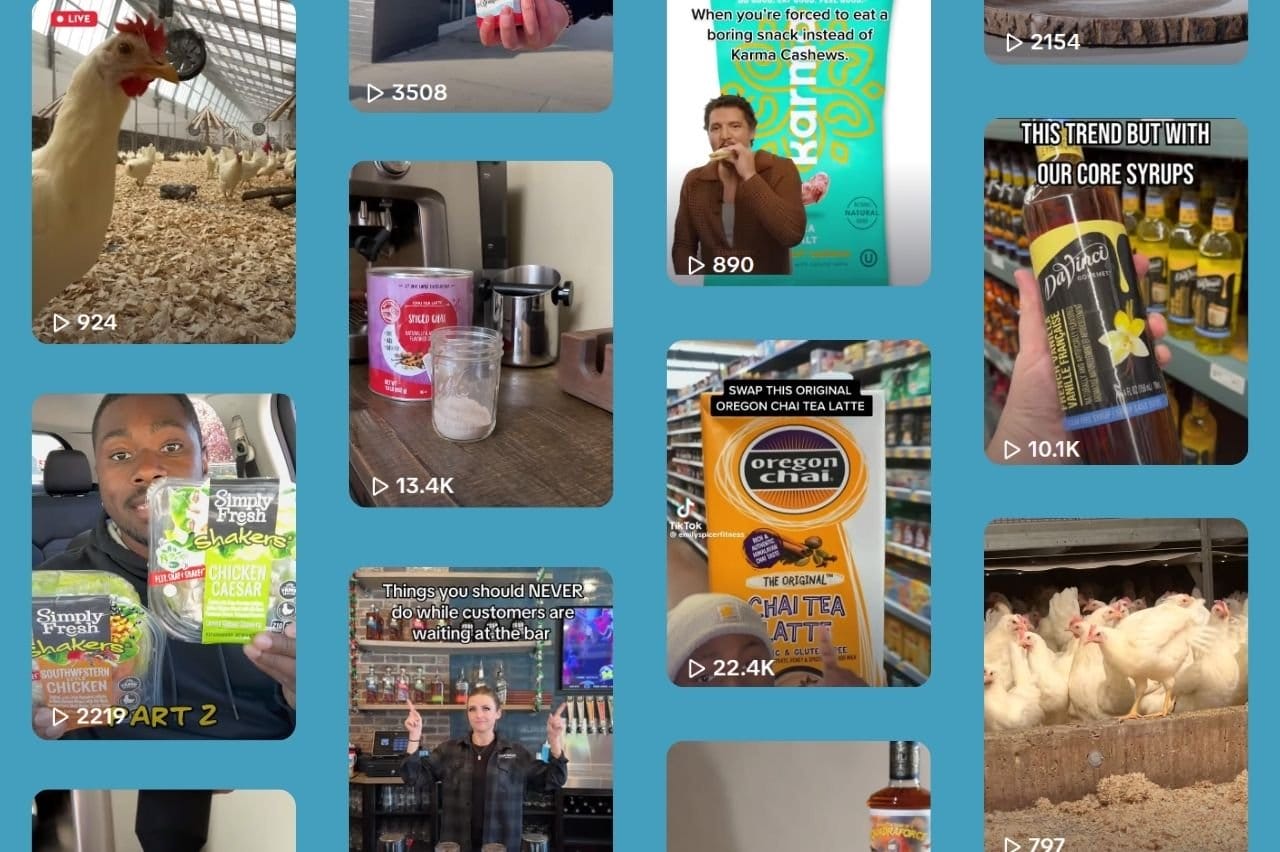How To Market Food Products: Social Media Marketing Tips for Food Product Marketing

Social media is beneficial in many ways, but it’s become an absolute necessity for food product marketing. Social connects people regardless of their location, keeps us updated on the latest news and trends, and provides a powerful tool for spreading the word about new food products.
Today’s top food brands are constantly looking for ways to maximize their reach and drive sales through social media. Many great food brands partner with a social media agency to build brand loyalty, garner trust, and connect with their consumers emotionally.
We’ve curated a list of social media marketing tips to get your food product marketing campaign going (Our team spends 300+ collective hours thinking about this every week… So hear us out).
Choose The Right Platform(s)
“Facebook is the most popular platform, with over 2.8 billion monthly active users. ”
Stastista
Not having an established and distinct social presence In today’s marketplace is like not even having a product to sell. Using a cross-platform social media strategy can make your offerings easily accessible online, give you a platform to market food products, share meals and recipes visually, enhance your brand community, and (perhaps most importantly) build trust.
“63% of food and beverage brands consider Instagram their most successful social media platform for content marketing.”
Social Media Today
According to Statista, Facebook is the most popular platform, with over 2.8 billion monthly active users. However, other platforms like Instagram, X, TikTok, Pinterest, and even LinkedIn offer unique opportunities for food product marketing. However, we recommend focusing on Facebook, TikTok, Pinterest and Instagram (you don’t necessarily need all 4, but it helps).

Depending on your brand’s specific goals and target market, you should consider what platform is most likely to reach your customers. It’s worth noting that, according to a Social Media Today report, 63% of food and beverage brands consider Instagram their most successful social media platform for content marketing.
Related: Pinterest Food Product Marketing Guide – Turn Pins Into Revenue Generators
Identify Your Content Strategy BEFORE Marketing Food Products
Content is king on social media (duh). When ironing out your content creation strategy, one of the most important things you need to establish is your customer’s problem and how your brand goes about solving that problem for them. This means ensuring that all content aligns with your brand’s voice, values, and general aesthetics. This will allow your brand to focus on topics that are relevant and meaningful to your customers.
It also means you’ll speak their ‘language’… A factor that’s becoming more important as Gen Z enters the workforce and their bank accounts grow.
The right content is essential to engage, inform and help consumers find relevance in a crowded food brand market. Here are some of our favorite content ideas for marketing food products:
- Blogs and videos with recipes: Highly shareable and offer consumers a visual guide to creating delicious meals at home.
- Behind-the-scenes content: Show the production process, spotlight team members, or feature brand values.
- Beverage pairings: Inspire consumers for their next meal or party.
- User-generated content: Encourage followers to share their own content, such as recipes or food photos, and repost them on your social media channels.
- High-quality product photos & videos: Visually appealing images can showcase a product’s features, enticing consumers to try them.
We recommend scheduling posts in advance to keep your social profiles active with social media bulk scheduling. Timing is very important for optimal posting times. Schedule posts when your target audience and followers are most active on social media. Most platforms have their own analytics, revealing consumers’ most active times. Remember, building a presence on social media is completely dependent on your content creation—especially in food product marketing, where visuals are everything and consumers demand to know every ingredient included in a product.
We don’t want to brag, but we have some solid pro photos on our Firebelly Marketing page.

Engage With Your Audience

Engagement is a critical component of food product marketing on social media. Responding to comments, messages, and mentions can create a sense of community and loyalty among your followers. Consumers appreciate brands that are approachable and responsive. It’s important to listen to your audience’s feedback and use it to improve your products and services.
Hosting live sessions, such as cooking demonstrations or Q&A sessions, can also enhance engagement (live streams are still popular).
These live interactions allow your audience to connect with your brand in real-time, making them feel more involved and valued. It also helps them get to know the ‘real’ you. And in a world where authenticity grows in importance, we can’t recommend this enough.
Polls, contests, and giveaways are other effective ways to boost engagement and create excitement around your food product marketing efforts.
Leverage Influencer Marketing
Influencer marketing has become a powerful tool in food product marketing.
Scratch that… It’s become an essential part of food product marketing.
Partnering with influencers who align with your brand values and have a strong following can significantly increase your reach and credibility. Influencers can create authentic content that showcases your products, providing social proof to their audience.
When choosing influencers to collaborate with, consider their engagement rates, audience demographics, and overall fit with your brand.
Don’t obsess over follower counts.
Micro-influencers, who have smaller but highly engaged followings, can be particularly effective for niche food products. Providing influencers with free samples or exclusive discounts can encourage them to share their genuine experiences with your products.
Run Social Media Ads
“Paid ads are ideal for precise targeting, measurable results, and enhancing reach and visibility.”
Paid advertisements allow your brand to reach a wider audience and stay top of mind. Meta remains the most popular channel for running ads, supplying the most detailed targeting options, including geo-targeting. However, other social media platforms like Pinterest and TikTok also offer robust advertising opportunities.
Pinterest, in particular, offers a great opportunity for food product marketing since consumers flock to the platform in search of recipes and food and beverage pairings. While Pinterest is known as a discovery channel, it has sophisticated full-funnel advertising capabilities.
Paid ads are ideal for precise targeting, measurable results, and enhancing reach and visibility. By monitoring key metrics such as click-through rates, conversion rates, and return on ad spend (ROAS), you can identify areas of improvement and optimize your ad campaigns accordingly. A/B testing different ad variations, targeting options, and ad placements can help refine your strategy and maximize your return on investment (ROI).
Measure and Analyze Performance

To ensure the success of your food product marketing efforts on social media, it’s essential to measure and analyze performance regularly. Utilize analytics tools provided by social media platforms to track metrics such as engagement, reach, impressions, and conversion rates. Understanding these metrics will help you gauge the effectiveness of your content and advertising strategies.
Regularly reviewing performance data allows you to identify what’s working and what’s not, enabling you to make data-driven decisions. Adjust your strategies based on insights gained from analytics to continually improve your social media marketing efforts.
The tricky part is finding trends in the data. Think outside the box and ask questions like:
- What’s similar about the first 2 seconds of our highest-performing Reels?
- Which TikTok captions are finding our audience?
- What questions are we asking in video descriptions that are getting the most engagement?
- Are videos featuring our food or people getting more traction?
📌 Most importantly: Prioritize engagement above all. If you’re generating comments, you’re generating hype.
Collaborate with a Social Media Marketing Agency
If marketing your food product seems daunting, partnering with a social media marketing agency like Firebelly can save time and serve as a more effective way to produce results for your business. An experienced agency can help you develop a comprehensive food product marketing strategy, create high-quality content, and manage your social media accounts.
Firebelly specializes in social media food product marketing. We understand the unique challenges and opportunities in the food industry and can tailor our services to meet your specific needs.
If you’re interested in having the conversation, just give us a shout. We’re experts in food product marketing and ready to help you achieve your goals.


